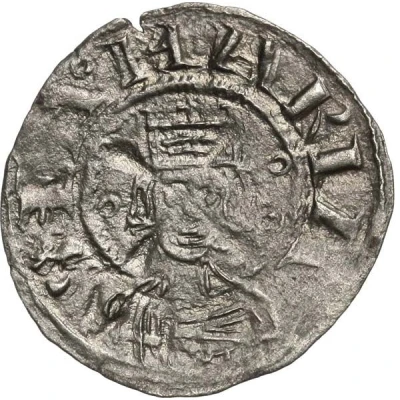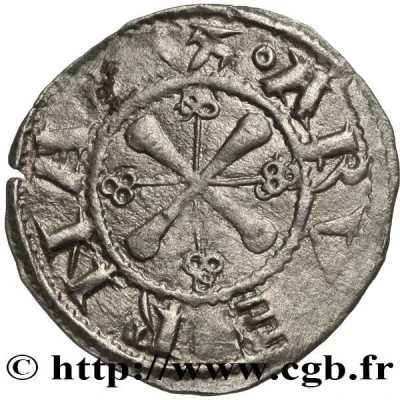


© CGB
Obol anonymous Bust ND
| Billon | 0.44 g | 15.5 mm |
| Issuer | Bishopric of Clermont (French States) |
|---|---|
| Type | Standard circulation coin |
| Years | 1200-1300 |
| Value | 1 Obol (1⁄480) |
| Currency | Livre |
| Composition | Billon |
| Weight | 0.44 g |
| Diameter | 15.5 mm |
| Shape | Round (irregular) |
| Technique | Hammered |
| Orientation | Variable alignment ↺ |
| Demonetized | Yes |
| Updated | 2024-10-04 |
| Numista | N#335044 |
|---|---|
| Rarity index | 94% |
Reverse
Cross with clovers in quarters linked to the center.
Script: Latin
Lettering: ✠ V- ° ARVERNA
Unabridged legend: Urbs Arverna
Translation: City of Clermont.
Comment
Coinage of the Virgin may have begun under the episcopates of Aimerie (1111-1150) or Étienne VI de Mercoeur (1151-1169). The heavy weight of some examples suggests the first possibility. Hugues de la Tour (1250-1286) was reprimanded by Alphonse de Poitiers (1241-1271), brother of Saint-Louis, for weakening coinage. In 1295, Philippe IV confirmed Adhémar de Cros's right to mint coins. The coinage of Clermont is still mentioned in 1315 under the episcopacy of Aubert de Montaigu (1307-1328).On this obol, the "E" in "SEA" is in fact a square C, the vertical bar of which is crossed out horizontally to form a cross and thus abbreviate the word. This type of abbreviation is also found, among others, on the denarii of the Abbey of Saint-Martial in Limoges, which also feature a frontal bust.
Variant: PA#2258.var
On the right, the head is framed by two trefoils at the top and two annulets at the bottom.
Interesting fact
One interesting fact about this coin is that it was used as a form of currency in the Bishopric of Clermont during the 13th century, which was a time of significant religious and political change in Europe. The coin's design, featuring an anonymous bust and lacking any written inscriptions, reflects the humility and simplicity that was encouraged by the Catholic Church during this period. Despite its small size and relatively low value, this coin played an important role in the local economy and offers a unique glimpse into the financial and cultural practices of medieval Europe.